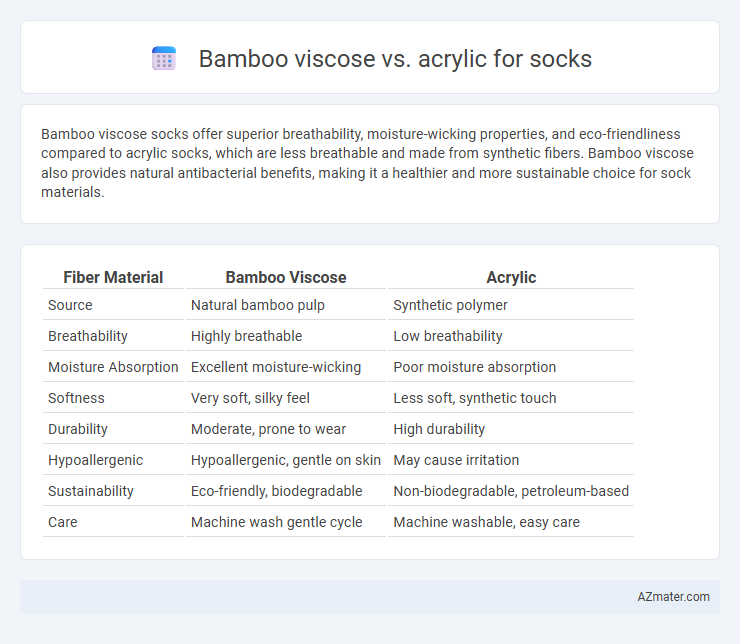Bamboo viscose socks offer superior breathability, moisture-wicking properties, and eco-friendliness compared to acrylic socks, which are less breathable and made from synthetic fibers. Bamboo viscose also provides natural antibacterial benefits, making it a healthier and more sustainable choice for sock materials.
Table of Comparison
| Fiber Material | Bamboo Viscose | Acrylic |
|---|---|---|
| Source | Natural bamboo pulp | Synthetic polymer |
| Breathability | Highly breathable | Low breathability |
| Moisture Absorption | Excellent moisture-wicking | Poor moisture absorption |
| Softness | Very soft, silky feel | Less soft, synthetic touch |
| Durability | Moderate, prone to wear | High durability |
| Hypoallergenic | Hypoallergenic, gentle on skin | May cause irritation |
| Sustainability | Eco-friendly, biodegradable | Non-biodegradable, petroleum-based |
| Care | Machine wash gentle cycle | Machine washable, easy care |
Introduction to Sock Materials: Bamboo Viscose vs Acrylic
Bamboo viscose socks offer superior moisture-wicking properties and natural antibacterial benefits, making them ideal for sensitive skin and prolonged wear. Acrylic socks provide excellent durability and vibrant color retention, suitable for active lifestyles requiring resilient fabric. Choosing between bamboo viscose and acrylic depends on prioritizing breathability and eco-friendliness versus long-lasting strength and easy care.
What is Bamboo Viscose? Key Properties Explained
Bamboo viscose is a semi-synthetic fiber derived from bamboo pulp, renowned for its softness, breathability, and moisture-wicking properties, making it ideal for sock fabrics. It exhibits natural antibacterial qualities and excellent thermal regulation, ensuring comfort and odor control in footwear applications. Compared to acrylic, bamboo viscose offers superior biodegradability and environmental sustainability, aligning with eco-friendly textile demands.
Understanding Acrylic Fiber: Composition and Qualities
Acrylic fiber is a synthetic polymer made primarily from polyacrylonitrile, known for its durability, lightweight nature, and resistance to moisture and UV rays. Unlike bamboo viscose, acrylic offers excellent color retention and quick-drying properties, making it suitable for socks requiring vibrant hues and frequent washing. Its insulating qualities provide warmth, but it lacks the natural breathability and antibacterial benefits found in bamboo viscose fibers.
Feel and Comfort: Which Material is Softer for Socks?
Bamboo viscose fibers provide exceptional softness and breathability, making socks feel smooth and gentle against the skin, ideal for sensitive or irritated feet. Acrylic, while offering durability and warmth, tends to feel less soft and slightly synthetic compared to bamboo viscose. For comfort and a silky, natural feel, bamboo viscose is typically preferred in sock materials.
Breathability and Moisture-Wicking: Bamboo Viscose vs Acrylic
Bamboo viscose fibers exhibit superior breathability and moisture-wicking properties compared to acrylic, making them ideal for socks designed to keep feet dry and comfortable. The natural structure of bamboo viscose allows enhanced air circulation and rapid moisture absorption, reducing sweat buildup and odor. Acrylic, being a synthetic fiber, tends to trap heat and moisture, resulting in less effective ventilation and slower drying times.
Durability and Longevity: Which Socks Last Longer?
Bamboo viscose socks offer superior durability due to their natural fiber strength combined with moisture-wicking properties that reduce wear and tear. Acrylic socks, while resistant to abrasion and retaining shape well, tend to pill over time, which can compromise their longevity. Overall, bamboo viscose socks generally last longer with consistent softness and structural integrity after multiple washes.
Sustainability and Environmental Impact Comparison
Bamboo viscose socks offer superior sustainability due to bamboo's rapid growth and minimal pesticide requirements, resulting in lower environmental impact compared to acrylic, which is derived from petroleum-based synthetic fibers with high carbon emissions. Bamboo viscose is biodegradable and promotes soil health, whereas acrylic contributes to microplastic pollution and is non-biodegradable, exacerbating landfill waste. Selecting bamboo viscose socks supports eco-friendly practices and reduces reliance on fossil fuels in textile production.
Hypoallergenic and Skin Sensitivity Factors
Bamboo viscose socks provide superior hypoallergenic properties due to their natural antibacterial and moisture-wicking qualities, reducing irritation for sensitive skin. Acrylic socks, while durable and soft, tend to retain heat and moisture, which can cause discomfort or allergic reactions in individuals with skin sensitivities. Choosing bamboo viscose enhances comfort and minimizes allergic responses, making it ideal for those with sensitive or allergy-prone skin.
Price and Accessibility: Bamboo Viscose vs Acrylic Socks
Bamboo viscose socks generally cost more than acrylic socks due to the natural fiber processing involved, but they offer superior breathability and sustainability. Acrylic socks are widely available and budget-friendly, making them accessible to a larger market despite lower moisture-wicking properties. Consumers seeking affordable options often prioritize acrylic socks, while those willing to invest in eco-friendly and comfort-focused products prefer bamboo viscose socks despite the higher price.
Final Verdict: Choosing the Best Material for Your Socks
Bamboo viscose socks offer superior moisture-wicking, antibacterial properties, and eco-friendliness compared to acrylic, making them ideal for sensitive skin and sustainability-conscious consumers. Acrylic socks provide durability and warmth but tend to retain odors and lack breathability, which can result in discomfort during extended wear. For optimal comfort, hygiene, and environmental impact, bamboo viscose is the preferred material for high-quality socks.

Infographic: Bamboo viscose vs Acrylic for Sock
 azmater.com
azmater.com